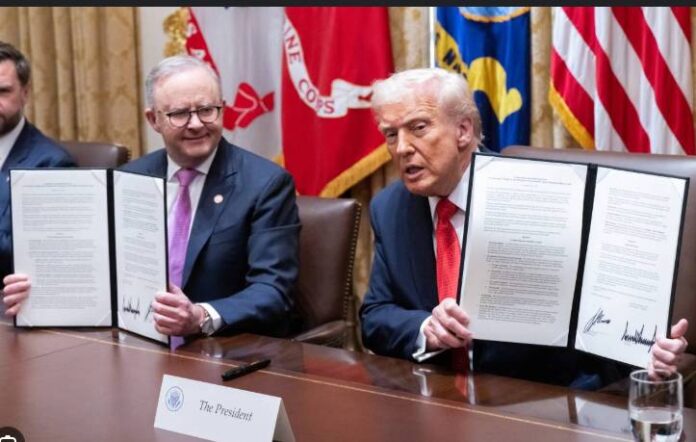New Minerals Deal Aims to Reduce Dependence on China
The United States and Australia have signed a significant new agreement to boost production and supply chains for rare earths and critical minerals, a move widely viewed as a direct challenge to China’s dominance in the global market.
Announced during a meeting in Washington, the deal will channel $1 billion in joint investments over the next six months into projects across both countries. The broader initiative, worth around $8.5 billion (A$13 billion), is expected to accelerate development in mining, refining, and supply of strategically important minerals.
Australian Prime Minister Anthony Albanese called the deal a “next-level partnership” that will help both countries secure resilient mineral supply chains crucial to modern industries ranging from electric vehicles and semiconductors to defence technology.
Trump and Albanese Highlight Deeper Strategic Ties

At the White House signing ceremony, US President Donald Trump and Prime Minister Albanese underscored that the partnership was not only economic but strategic.
“This is about ensuring that the free world controls the resources it needs,” President Trump said. “We’re securing our supply lines and building prosperity with our allies.”
The announcement coincided with renewed discussions around the AUKUS defence pact, under which Australia is set to acquire nuclear-powered submarines from the US and UK. Addressing concerns about delays, Trump confirmed that the submarine program was “full steam ahead,” dismissing speculation that it might be scaled back under his administration’s “America First” review.
China’s Market Dominance Sparks Urgency

China currently commands around 70% of global rare earth mining and 90% of the processing capacity — giving it immense leverage over industries that rely on these materials.
The minerals are essential components in everything from fighter jets and missile systems to smartphones and electric cars.
Over the past year, Beijing has introduced new export restrictions on certain rare earths and metals in retaliation for US trade tariffs, further heightening global supply concerns.
Washington views the latest deal with Canberra as a strategic hedge to diversify sourcing and reduce dependence on China’s supply chain.
Australia to Host New Processing Facilities
As part of the agreement, the two countries will co-invest in mineral processing plants and research facilities in both the United States and Australia. The US government also confirmed plans to fund a 100-tonne-per-year advanced gallium refinery in Western Australia, a critical step toward localizing high-value refining.
Additionally, the US Export-Import Bank is preparing $2.2 billion in financing for critical minerals ventures, including projects by leading companies such as MP Materials, Trilogy Metals, and Lithium Americas.
In exchange for financial support, Washington has sought minor equity stakes in partner firms to ensure long-term supply security.
Australian Mining Sector Sees Market Boost
The deal sparked an immediate rally in the Australian mining sector, with shares in Arafura Rare Earths surging by 7.7% and Iluka Resources gaining more than 3% on Tuesday.
Investors reacted positively to the expected inflow of funding and policy stability, anticipating a faster approval process for new projects under the agreement’s streamlined framework.
Companies such as Lynas Rare Earths, already under contract with the US Department of Defense, are expected to play a key role. Lynas, which is developing a major project in Texas, stands to benefit from increased American demand and technology-sharing incentives.
Broader Economic and Strategic Implications
Analysts say the deal is part of a larger Western effort to counter China’s economic influence in critical technology supply chains.
The US-Australia framework also includes coordination on pricing, export controls, and foreign investment reviews, ensuring that sensitive projects remain within allied control.
For Australia, the deal presents an opportunity to move up the value chain — from raw mineral exporter to a global hub for processing and advanced materials.
For the United States, it represents progress toward energy security and industrial independence, as the country accelerates efforts to build a domestic green-tech ecosystem.
Balancing Trade and Strategic Interests
Despite the growing alignment with Washington, Canberra remains cautious about its relationship with China, its largest trading partner.
Experts note that while Australia is eager to expand cooperation with the US, it must manage a delicate balance to avoid provoking economic retaliation from Beijing.
Prime Minister Albanese, however, emphasised that the deal is not about confrontation but about “building reliable, transparent, and sustainable supply chains.”
He added that both nations “share the same commitment to economic resilience, clean energy transition, and regional stability.”
Strengthening the Alliance for a Secure Future
The rare earths pact follows a series of strategic investments by the Trump administration aimed at fortifying Western control over critical minerals.
With China’s market share still overwhelming, Washington and Canberra’s partnership is seen as a key milestone toward diversifying the global rare earths landscape.
Both leaders described the agreement as a “historic step forward” in strengthening not only economic cooperation but also the defence and technological alliance between the two nations.

